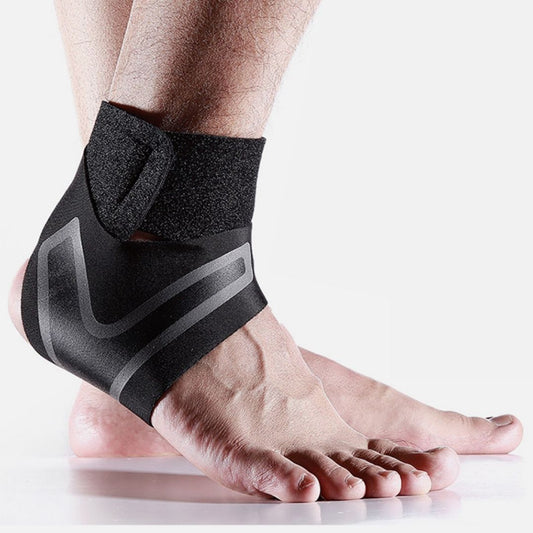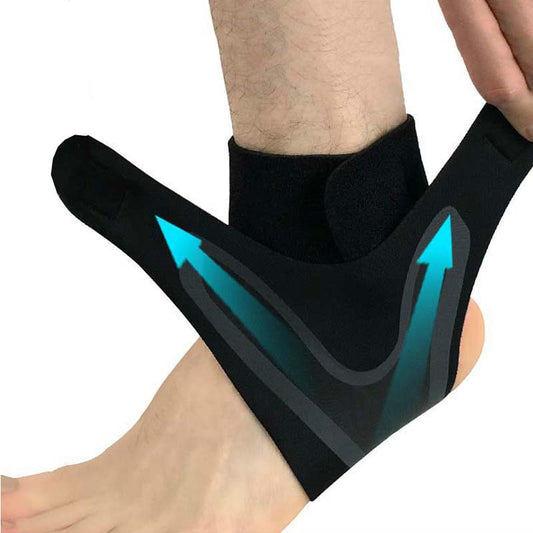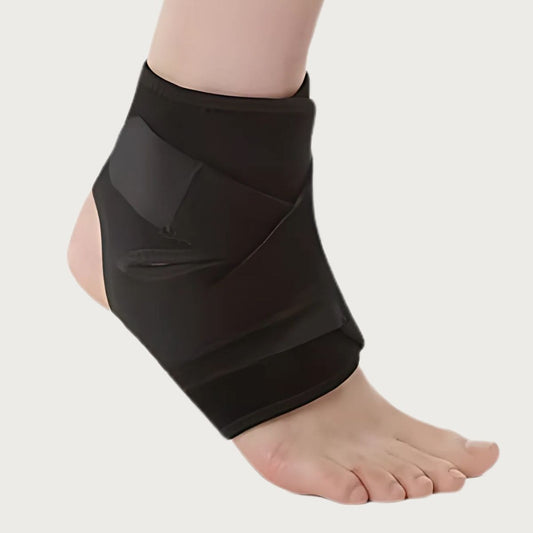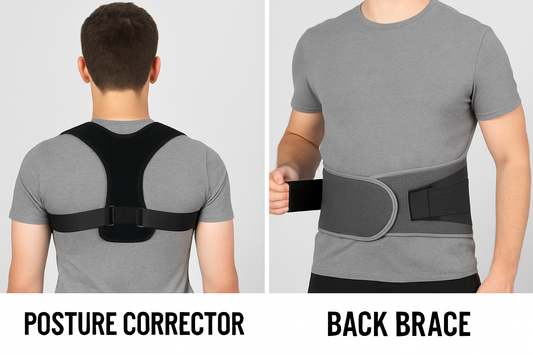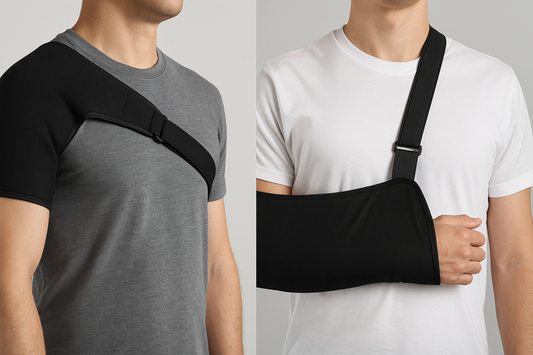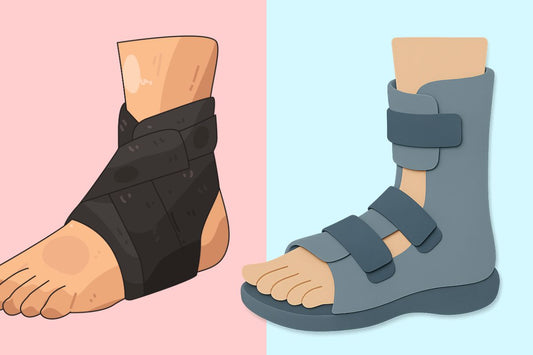When you injure your ankle, one of the first questions is how much support you actually need. Some people are told to wear an ankle brace, while others are put into a walking boot. At first glance, both seem designed to protect and stabilize your ankle — so which one is right for you?
Are Ankle Braces and Walking Boots the Same?
Not quite. Both braces and boots are meant to stabilize and protect an injured ankle, but they are different levels of support.
- An ankle brace provides light to moderate stability, allowing controlled movement while reducing strain on healing tissues.
- A boot (often called a walking boot or orthopedic boot) offers rigid immobilization, limiting almost all ankle motion to protect the joint from further damage.
Think of it this way: A brace is like a seatbelt — it allows normal activity but keeps you safe. A boot is like a full protective cage — it prioritizes protection over mobility.
Key Differences Between an Ankle Brace and a Boot
| Feature | Ankle Brace | Walking Boot |
|---|---|---|
| Design | Lightweight, often elastic or lace-up with straps | Rigid, bulky boot with hard outer shell |
| Support Level | Mild to moderate stabilization | Strong immobilization, restricts movement |
| Mobility | Allows walking, exercise, and daily activity with support | Limits ankle motion, heavier to wear |
| Primary Purpose | Prevents re-injury, supports during activity | Protects and immobilizes serious injuries |
| Comfort | Slim, can be worn with regular shoes | Bulky, usually replaces normal footwear |
| Duration of Use | Short- to medium-term, even long-term prevention | Short-term, used during acute healing |
When to Use an Ankle Brace vs a Boot
Ankle Brace
An ankle brace is designed for support without completely taking mobility away. Typically made from elastic, neoprene, or a lace-up design with straps, it applies compression to reduce swelling and keeps the joint stable while still allowing you to move. Because of its lighter profile, it can be worn with most types of shoes and is suitable for long-term use if needed.
Ideal for:
- Mild ankle sprains or strains: Helps reduce pain and stabilize ligaments without over-restricting motion.
- Chronic instability: Beneficial for people who frequently “roll” their ankles or have a history of repeated sprains.
- Athletic recovery and prevention: Athletes in basketball, soccer, running, or tennis often use braces when returning from injury to prevent setbacks.
- Daily activity support: Useful for walking, light exercise, or work that requires standing for long hours.
- Post-boot recovery: Often prescribed after wearing a boot to transition back into normal footwear with added support.
Walking Boot
A walking boot (orthopedic boot) is a much more rigid device. Built with a hard outer shell and cushioned liner, it immobilizes the ankle joint to give tissues time to heal without repeated stress. Because it replaces normal footwear, it’s generally used short-term during the acute phase of recovery.
Ideal for:
- Moderate to severe ankle sprains: Provides the higher level of stability needed for significant ligament injuries.
- Fractures: Used for broken bones in the ankle or foot where strict immobilization is required.
- Post-surgical recovery: Ensures protection and limits weight-bearing after ankle or foot surgery.
- Severe ligament tears: When rest and rigid support are critical for proper healing.
- Situations requiring protection from weight-bearing: Boots distribute pressure more evenly, reducing strain on the injured area.
Can They Be Used Interchangeably?
For the most part, no — ankle braces and boots serve different purposes. A brace is designed to stabilize and protect during motion, while a boot is intended to immobilize and restrict nearly all ankle movement.
That said, there is some overlap in recovery. For example:
- Someone with a moderate sprain might begin treatment in a walking boot to enforce rest and then transition into an ankle brace for support as they return to normal activities.
- Athletes may use braces after completing boot treatment to safely resume training.
However, using a brace when a boot is required — such as for fractures or post-surgical recovery — risks re-injury and delayed healing. Similarly, wearing a boot unnecessarily for a mild sprain can weaken surrounding muscles and prolong recovery.
In short: while both devices protect the ankle, they are not direct substitutes. Correct use depends on the severity and stage of the injury.
How to Decide Between an Ankle Brace and a Boot
-
Assess the injury severity:
- Mild pain, swelling, or instability → Ankle brace.
- Severe pain, inability to bear weight, visible deformity, or fracture → Walking boot (and medical evaluation).
-
Consider your activity level:
- Athletes or active individuals often prefer braces that let them move while still providing protection.
- People recovering from significant injuries need the immobilization of a boot before they can return to activity.
-
Think about daily comfort and practicality:
- Braces are slim, discreet, and can be worn inside regular shoes.
- Boots are bulkier and heavier but essential for serious protection.
-
Follow professional guidance:
- If you suspect a fracture or major ligament tear, always consult a healthcare professional before choosing.
- Many treatment plans involve starting in a boot, then progressing to a brace as healing allows.
Ankle Brace vs Boot: The Bottom Line
When comparing an ankle brace vs boot, the difference comes down to mobility versus immobilization. Ankle braces are lightweight, versatile, and perfect for mild sprains, chronic instability, and prevention — they let you stay active while protecting the joint. Walking boots, on the other hand, are rigid, protective, and reserved for more serious conditions like fractures, post-surgical recovery, or severe ligament injuries.
They are not true substitutes for one another, but they can complement each other as part of a recovery plan: starting with a boot for protection, then transitioning to a brace for safe mobility.
The bottom line: choose the device that matches the severity of your condition and your stage of healing. And when in doubt, consult a healthcare provider to ensure you’re giving your ankle the support it needs to heal properly.


